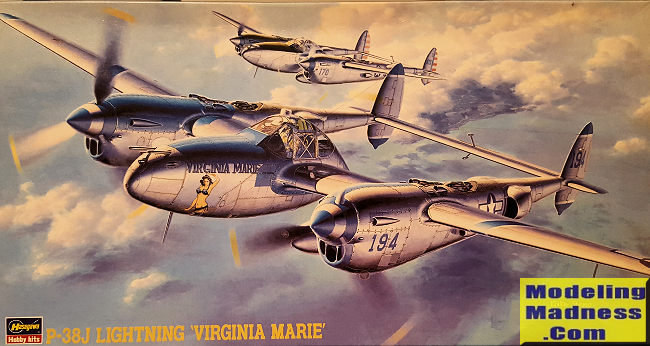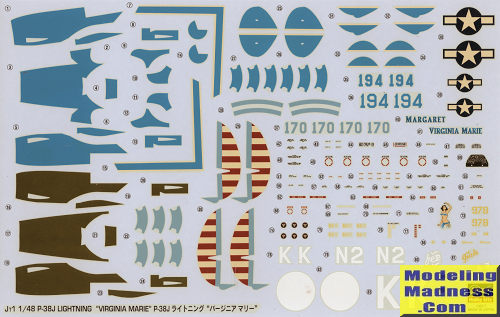
| KIT #: | 09101 (Jt 1) |
| PRICE: | 3600 yen when new |
| DECALS: | Three options |
| REVIEWER: | Scott Van Aken |
| NOTES: | Initial 1993 release |

| HISTORY |
The P-38J was introduced in August 1943. The turbosupercharger intercooler system on previous variants had been housed in the leading edges of the wings and had proven vulnerable to combat damage and could burst if the wrong series of controls was mistakenly activated. In the P-38J series, the streamlined engine nacelles of previous Lightnings were changed to fit the intercooler radiator between the oil coolers, forming a "chin" that visually distinguished the J model from its predecessors. While the P-38J used the same V-1710-89/91 engines as the H model, the new core-type intercooler more efficiently lowered intake manifold temperatures and permitted a substantial increase in rated power. The leading edge of the outer wing was fitted with 55 US gal (210 l) fuel tanks, filling the space formerly occupied by intercooler tunnels, but these were omitted on early P-38J blocks due to limited availability.
The final 210 J models, designated P-38J-25-LO, alleviated the compressibility problem through the addition of a set of electrically actuated dive recovery flaps just outboard of the engines on the bottom centerline of the wings. With these improvements, a USAAF pilot reported a dive speed of almost 600 mph (970 km/h), although the indicated air speed was later corrected for compressibility error, and the actual dive speed was lower. Lockheed manufactured over 200 retrofit modification kits to be installed on P-38J-10-LO and J-20-LO already in Europe, but the USAAF C-54 carrying them was shot down by an RAF pilot who mistook the Douglas transport for a German Focke-Wulf Condor. Unfortunately, the loss of the kits came during Lockheed test pilot Tony LeVier's four-month morale-boosting tour of P-38 bases. Flying a new Lightning named Snafuperman, modified to full P-38J-25-LO specifications at Lockheed's modification center near Belfast, LeVier captured the pilots' full attention by routinely performing maneuvers during March 1944 that common 8th Air Force wisdom held to be suicidal. It proved too little, too late, because the decision had already been made to re-equip with Mustangs.
The P-38J-25-LO production block also introduced hydraulically boosted ailerons, one of the first times such a system was fitted to a fighter. This significantly improved the Lightning's rate of roll and reduced control forces for the pilot. This production block and the following P-38L model are considered the definitive Lightnings, and Lockheed ramped up production, working with subcontractors across the country to produce hundreds of Lightnings each month.
| THE KIT |
 Prior
to the release of this kit in 1993, the most popular 1/48 P-38 was the
Monogram kit, which was released in 1964. While Aurora put out a Lightning
in this scale in 1963, it was not a particularly accurate kit and the
Monogram kit allowed one to build one of several variants. It was not a
simple build and until Tamiya released their kit recently, none of the 1/48
P-38s were easy to complete.
Prior
to the release of this kit in 1993, the most popular 1/48 P-38 was the
Monogram kit, which was released in 1964. While Aurora put out a Lightning
in this scale in 1963, it was not a particularly accurate kit and the
Monogram kit allowed one to build one of several variants. It was not a
simple build and until Tamiya released their kit recently, none of the 1/48
P-38s were easy to complete.  Instructions
are standard fare with Gunze paint references. There are three options. Two
are unpainted metal, with one being the box art plane from 475 FG. Another
is a Pacific Lightning from the 433rd FS with red and white stripes on the
rudder. The third is a European plane in OD over neutral grey with the 364th
FG that has yellow forward engines. The very large decal sheet is nicely
printed and old school with off-white white sections. Though these decals
may not be viable any more, there are a lot of aftermarket offerings.
Instructions
are standard fare with Gunze paint references. There are three options. Two
are unpainted metal, with one being the box art plane from 475 FG. Another
is a Pacific Lightning from the 433rd FS with red and white stripes on the
rudder. The third is a European plane in OD over neutral grey with the 364th
FG that has yellow forward engines. The very large decal sheet is nicely
printed and old school with off-white white sections. Though these decals
may not be viable any more, there are a lot of aftermarket offerings.
| CONCLUSIONS |
Though the current Tamiya offering is undoubtedly the best available in this scale, it is not inexpensive. The Hasegawa kit is not a kit for beginners, but anyone who considers themselves an experienced modeler, should not have any major issues building this one.
| REFERENCES |
https://en.wikipedia.org/wiki/Lockheed_P-38_Lightning#P-38J,_P-38L
July 2022
Copyright ModelingMadness.com. All rights reserved. No reproduction in part or in whole without express permission from the editor.
If you would like your product reviewed fairly and quickly, please contact the editor or see other details in the Note to Contributors.